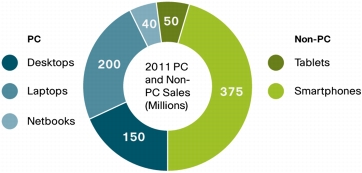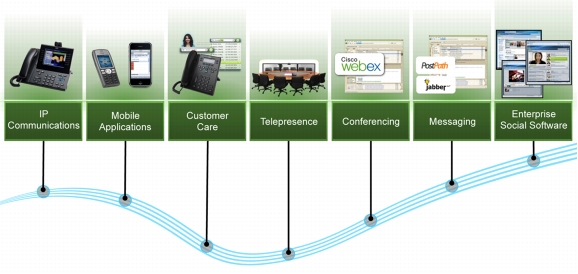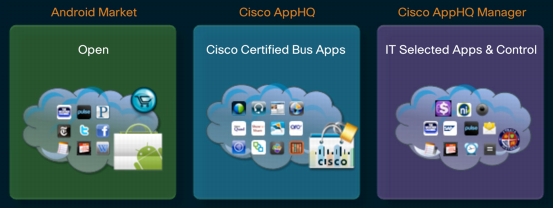What You Will Learn
• Will you use your tablets to run, grow, or transform your business?
• Will you develop your own tablet applications, purchase them, or both?
• Do you want tablet users to videoconference with colleagues, customers, suppliers, and partners?
• How will you deliver and manage applications at scale?
• How will you balance flexibility and security?
• Will your tablets be part of larger consolidation or cloud initiatives?
• What level of service and support will you require from your tablet vendor?
Figure 1. The Evolving Workspace: Mobile, Virtual, and Visual
|
2011 |
2012 |
2013 |
 |
 |
 |
|
Fifty Percent of Computing Devices Will Be Smartphones and Tablets1. |
Forty Percent of Businesses Will Use Cloud-Based Services2. |
Ninety Percent of Network Traffic Will Be Video3. |
|
1Deloitte, http://economictimes.indiatimes.com/tech/hardware/tablets-smartphones-to-eclipse-pcs-in-2011-deloitte/articleshow/7469526.cms
3Cisco Visual Networks Index Forecast
|
The Rapidly Evolving Workspace
• Mobile: By 2012, mobile users will make up 73 percent of the enterprise workforce, according to research from Forrester1. With so many mobile employees, ubiquitous access to network resources has become business-critical. Research by industry analyst Chadwick Martin Bailey shows that by extending unified communications and collaboration to mobile workers, companies can obtain up to 2 hours of more productive work from employees every day2.
• Virtual: Cloud computing is now an established deployment model. Applications, data, and even operating systems can be securely and reliably delivered from private or public clouds through intelligent networks that connect the many devices people use. Gartner predicts that by 2012, 40 percent of businesses will meet their communications needs by using a blend of premises-based services and Internet or cloud-based services, compared to 3- to 5-percent of businesses in 2009.
• Social: Traditional applications are being replaced by social media. Gartner predicts that by 2014, social networking services will replace email as the primary vehicle for interpersonal communications for 20 percent of business users3. This trend will result in communications moving beyond one-to-one to many-to-many and it will enable innovation with unprecedented scale and speed.
• Visual: The prolific use of video, with YouTube and social networking sites such as Facebook, has made video the new voice. Cisco predicts that by 2013, 90 percent of traffic on networks will be video. Pervasive video will make it possible for employees to effectively and efficiently share ideas and expertise while reducing corporate operating expenses.
The Rise of the Tablet
Figure 2. According to Deloitte, More Than Half of All Computers Are Not Computers Anymore

• The mobile workforce
• The virtual desktop
• The social enterprise
• The visual network


Considerations for Tablets in a Business Environment: Go Beyond Hardware Comparisons

Cisco Cius: Designed for Business
Figure 3. Cisco Cius Is a Mobile and Desktop Collaboration Device

• Integrated collaboration: In addition to industry-leading Cisco® Unified Communications applications, Cisco Cius comes equipped with Cisco Collaboration applications. Among these market-leading applications will be Cisco WebEx® meeting applications for conferencing; Cisco Jabber™ messaging for integrated presence and IM; and Cisco Quad™ social software for virtual teaming, secure communities, and content tagging for information exchange.
• Virtualization and cloud computing: Cisco Cius is ready to run a virtualized desktop, so you can flexibly, transparently, and securely host software applications in the data center and give users on-demand access to applications and network services through the cloud - without having to worry about data theft.
• Ubiquitous computing and transparent mobility: With resident computing, storage options, and unrestricted connectivity, you don't need to be in an office to be productive. Cisco Cius gives you the power to compute, communicate, and collaborate everywhere with confidence.
• High-definition (HD) video interoperability: Interoperability with all Cisco video endpoints and multivendor solutions facilitates greater participation and productivity and a rich video experience, and provides exceptional value because Cisco Cius works with the products you already have.
• End-to-end security: Cisco provides enterprise-grade security for Cisco Cius, which includes device security, network security, and mobile security. Security policies and quality of service (QoS) are enforceable across the network because Cisco Cius is a recognized network endpoint. Application security is provided with Cisco AppHQ, a trusted source for Cisco Cius applications that undergo comprehensive security testing by Cisco before being published to the Cisco AppHQ user storefront.
• Centralized device and application manageability: The same engine that powers Cisco Collaboration (Cisco Unified Communications Manager) provides central device management so no additional "bolt-on" Mobile Device Management (MDM) service is required. Centralized application management is also enabled with the optional Cisco AppHQ Manager, which provides a comprehensive set of IT management tools and reporting. Cisco AppHQ Manager also enables customers to create their own "app center within a center", where they determine which apps are made available to users.
• Enterprise-grade service and support: Cisco has more than 25 years of experience supporting the enterprise with centralized tech support and 24-hour replacement and warranty options for Cisco Cius, in addition to offering customers a wide array of advanced services.
• Developer community: Cisco AppHQ provides the resources and tools Android developers need to create and market compelling enterprise applications that can redefine the way employees perform their work.
Business-Class Collaboration: Look for Industrial-Strength Applications and Interoperability
• According to a recent Frost and Sullivan survey, "organizations that have deployed collaboration technologies experienced a whopping 400 percent-plus return on their investment."5 When it comes to business tablets, the tighter the integration, the more efficient tablet computing will be and the higher user productivity and ROI will be.

• Launch meetings directly from the phone dialer
• Book meetings directly from a contact's information
• Start an individual or group chat with meeting participants
• Escalate a chat conversation into a meeting
• Schedule and start meetings directly from the calendar
• Record calls and retain call histories for regulatory compliance
• Have video conference calls with people who use different devices
Figure 4. Cisco Cius Delivers Integrated Access to a Full Suite of Collaboration Applications

• Cisco TelePresence® Systems
• Cisco TelePresence EX Series
• Multivendor solutions
Business-Class Connectivity: Look for Flexible, Ubiquitous, Low-Cost Connectivity
• Power over Ethernet (PoE): In addition to battery operation, Cisco Cius can be powered with 802.3at PoE switches or locally powered with a power supply.
• Wired connectivity: Desktop docking with the optional HD media station, which supports 10/100/1000 (Gigabit) Ethernet, delivers cost-effective connectivity at the desktop.
• Wi-Fi everywhere: Together, the Cisco Cius tablet and the Cisco Unified Wireless LAN "n" network bring a secure, reliable, high-quality-performance network solution. Cost-effective on-campus, at-home, and hotspot mobility is enabled with 802.11a/b/g/n Wi-Fi.
• Network users can benefit from Cisco Clean Air Technology, which detects RF interference that other systems cannot see, identifies the source of the interference, and automatically adjusts the wireless network to reduce downtime. Cisco Compatible Extensions v5.0 helps ensure QoS and extends tablet battery life.
• Broadband connectivity: Off-campus mobile collaboration and computing is provided through 4G data services, planned for CY2011.
• Transparent roaming: Signaling is directed over the wireless LAN (WLAN) network, even when the tablet is docked in the HD media station and is using wired connectivity. Transition from wired to Wi-Fi as users roam on campus does not require user intervention in their communications and collaboration activities.
• Lower overall tablet cost: Users can take advantage of the campus network when on campus and rely on 4G data cellular services only when outside Wi-Fi range, reducing overall operating costs.
Business-Class Security: Look for End-to-End Security
• A highly secure remote connection through the Cisco AnyConnect™ VPN Client, which comes standard.
• Secure boot, secure credential storage, image authentication and encryption, random bit generation, and hardware cryptographic acceleration.
• Media and data encryption through Transport Layer Security/Secure Real-Time Transport Protocol (TLS/SRTP) and Secure HTTP (HTTPS) for client browsings.
• Wired network security through IEEE 802.1x for authentication prior to network admission when users are off campus.
• Flexible wireless network security with Wi-Fi Protected Access 2 (WPA-2); Wired Equivalent Privacy (WEP), which is often used in home networks; and Extensible Authentication Protocol and Secure Tunneling [EAP-FAST] for enhanced security.
• The ability to "vet" applications from third-party Android developers and Android marketplaces, prior to permitting downloads or bulk provisioning, through the Cisco AppHQ Manager and Cisco Unified Communications Manager.
• Multiple Remote Wipe features from Cisco Unified Communications Manager, if the tablet is lost or stolen.
Business-Class Manageability: Look for Centralized Provisioning and Device Management
• Streamline deployment time-to-live and reduce costs through bulk provisioning
• Retain a common dialing plan across Cisco endpoints
• Enable or disable USB, Secure Digital (SD) cards, Bluetooth, and Wi-Fi services by user profile
• Prioritize real-time video communications and help ensure QoS through network policy controls

Figure 5. Companies Have Many Application Deployment Options with Cisco Cius

• Push applications through the native application deployment capabilities of Cisco Unified Communications Manager, with zero-touch provisioning. Administrators can easily add or remove applications from devices, by user, by groups of users, across an entire company, or by device (for example, a Cisco Cius tablet).
• Restrict employee access to only applications that are published to Cisco AppHQ. Cisco AppHQ, hosted by Cisco, is an ecosystem for the new class of collaborative applications supported on the Cisco Cius tablet. Cisco AppHQ can be accessed directly from a factory-installed client app on the Cisco Cius business tablet, providing a trusted source for a wide variety of Cisco-selected and validated applications. Cisco AppHQ blends the needs of enterprise IT with the user-friendly storefront experience of consumer marketplaces.
• Create a custom applications center with Cisco AppHQ Manager, which provides administrator-friendly tools that give IT even more control. Cisco AppHQ Manager provides a secure, simple, and efficient way to deploy and centrally manage free, purchased, and in-house Android-developed applications to selected users, groups of users, or an entire enterprise of Cisco Cius users. Other management capabilities enabled by Cisco AppHQ Manager include application tracking by device, encrypted storage and communications, and flexible licensing and purchasing options.
Business-Class Service and Support: Look for a Proven Record in the Enterprise
• What happens if a user drops a tablet? Can you get a replacement 24 hours a day?
• What do you do if you have questions about software? Is there a 24-hour help line?
• What about interoperability? Is your business expected to "vet" applications? Or will your tablet vendor do it for you?
• Worry-free hardware
• Ease of deployment
• Apps within Cisco AppHQ that have been vetted on Cisco Cius by Cisco
• Cisco Accidental Damage Protection Service, which provides next-business-day replacement for a cracked screen, drop, or spill
• Cisco Unified Communications Plan and Design Services
• The support team's email address: as-cius@cisco.com
Business-Class ROI: Look for Hard Dollar Return On Investment
• Give sales teams a more engaging way to share promotional materials
• Make physician interactions with patients more personal
• Make long-distance immersive learning experiences in educational institutions possible
• Make it easy to engage with experts regardless of where they are located
• Transform order entry for enhanced customer service
• Empower field personnel in public sectors with secure, comprehensive, regulatory-compliant communications
Conclusion
For More Information